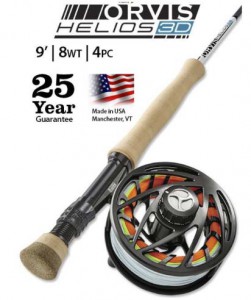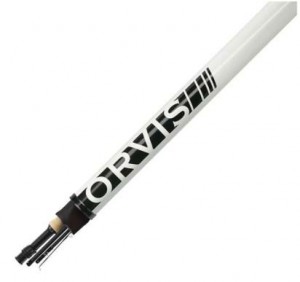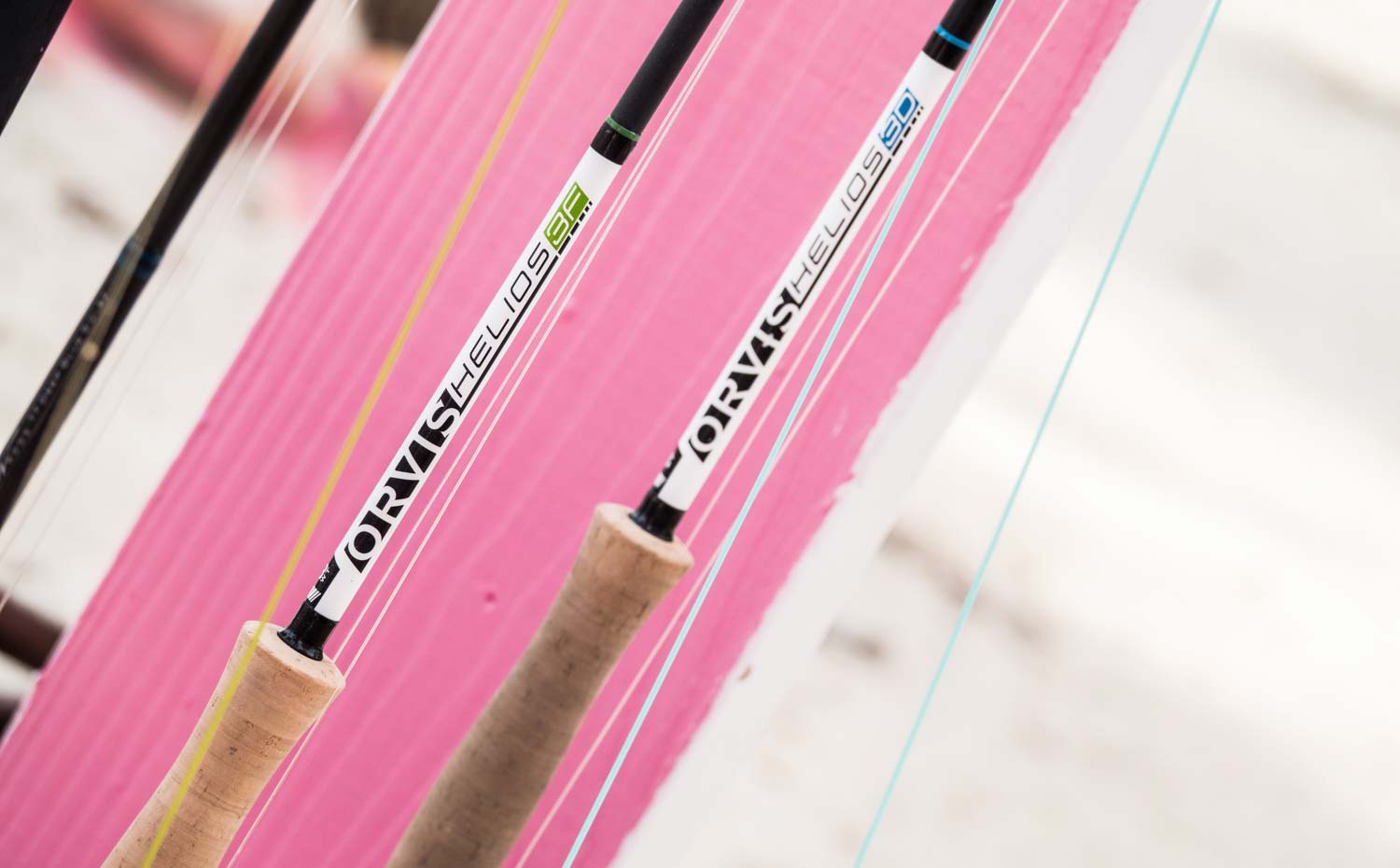Which Helios 3 fly rod is right for the saltwater angler?
I have spent the last two weeks fly fishing for bonefish in the Bahamas. As you would expect, there were some beautiful days and some real howlers. In my rod quiver for the trip were two Helios 3 eight weights, the F and the D. It was the perfect opportunity to test each of these rods for their strengths and their weaknesses.
So what’s up with the F and D?
With the introduction of the Helios 3, Orvis dropped their description of fly rods as “tip flex” and “mid flex,” opting for the distinctions of D for distance and F for feel. The idea, I believe, was to give the consumer some idea what these rod actions might be used for rather than expecting them to understand the technical aspects of rod flex. I don’t know that “distance” and “feel” tell the whole story but the idea may be more approachable for some anglers.
Is the H3 really that accurate?
You’ve likely seen the ads claiming that the Helios 3 is the most accurate fly rod ever made. That’s quite a claim and one which is certainly difficult to either prove or disprove. It would be easy to dismiss as pure marketing but I do believe there is more to it.
Orvis is actually very good with their science. Even before Sean Combs, who brings with him a serious technical background, joined the company Orvis was very diligent with their collection and use of data. I have seen the testing they performed on the H3 and it is impressive.
The fundamental idea behind the claim of accuracy is that the new H3 tracks true during the casting stroke. That is to say that there is very little side-to-side movement of the rod blank and it loads and unloads. It is factual that a rod which tracks truer is capable of making a more accurate cast. That’s the science and, in that regard, the H3 is everything Orvis claims.
Having a rod that is capable of extreme accuracy and making extremely accurate casts are two very different things. There are casters who will see the difference in their casting accuracy and a great many who will not. The rod is a tool and performs no better than its user. It would be ridiculous to believe that, as a caster, you can buy accuracy.
Orvis did put a lot of work and science into making a fly rod which is capable of delivering a very precise cast. I can’t help but believe that they did this because it’s something their competition doesn’t do very well. You might be surprised to see the tracking data from some very popular and expensive rods. So, Orvis is clearly attacking their competition where they are weakest. That, I suppose, is the marketing so make of it what you will.
How true a fly rod tracks either matters to you or it doesn’t, but in my opinion it’s not the most compelling thing about the Helios 3. The H3 is easily one of the best casting rods on the market and what is of particular interest to me are the characteristics of the the F and D individually and as a set.
The Helios 3D
 The 3D is a thunderstick. You might expect this from it’s distinction as a “distance” rod. It is a stiff, powerful beast with a blindingly fast recovery. Distance? Sure, but also line speed and ultra-tight loops. So, for me, as a bonefish rod, the beauty of the 3D is it’s ability to dominate the wind.
The 3D is a thunderstick. You might expect this from it’s distinction as a “distance” rod. It is a stiff, powerful beast with a blindingly fast recovery. Distance? Sure, but also line speed and ultra-tight loops. So, for me, as a bonefish rod, the beauty of the 3D is it’s ability to dominate the wind.
Fishing this rod in the worst conditions, I was able to put my fly in front of fish I would have missed without it. In this regard, the 3D lived up to its claim of accuracy in a real-world scenario. By punching through the wind and delivering the energy to turn over the leader, it made accurate casts possible in the worst conditions and that absolutely translates into more fish caught.
If there is a downside, it’s that the 3D may not be immediately approachable to every angler. Any super-fast action rod requires good technique to load and cast well. If you struggle with timing and loop control, the 3D will demand your complete attention. If you have a clean stroke and good timing, it will sing.
I like the 3D set up with a 3/4 overweight, head-heavy line like the Airflo Tropical Punch, SA Titan or Orvis Ignitor. It also performed well with a more technical, long-belly line when over weighted by one line weight.
The Helios 3F
 The 3F is the kinder, gentler H3. As promised, the 3F provides the angler with more feedback during the casting stroke. It is easier to load with an easy stroke and will be much more approachable to the average angler. In spite of the F and D distinction, you don’t really sacrifice distance with the 3F. In the hands of a good caster, it is perfectly capable of casting a full fly line.
The 3F is the kinder, gentler H3. As promised, the 3F provides the angler with more feedback during the casting stroke. It is easier to load with an easy stroke and will be much more approachable to the average angler. In spite of the F and D distinction, you don’t really sacrifice distance with the 3F. In the hands of a good caster, it is perfectly capable of casting a full fly line.
Although it falls short of the 3D when it comes to punishing wind, it offers an important substitute—presentation. Anyone who has done much bonefishing will tell you that the only thing tougher than a stiff wind is dead calm. When the water is still, it becomes a real challenge presenting the fly without spooking fish. A rod which allows a gentle cast with a lighter line is a big asset.
I found the 3F to be a wonderful tool when stalking tailing fish on foot. It made techniques like the Tear-Drop cast effortless and caught me a lot of fish. For the average angler, fishing in reasonable conditions, it’s the perfect tool for the job. In wind under 15 MPH, the 3F works for you. For any application outside saltwater, the 3F is also a great choice.
I paired the 3F with a RIO Flats Pro line. A true weight fly line and longer taper. The lighter line makes soft presentations much easier and it was a perfect match for the rod.
The 3F and 3D as a pair
It is my practice to carry two 8 weights when bonefishing. One rod with a heavy, weight forward line for high wind, and one rod with a lighter, more technical line for calm days. The Helios 3F and 3D work perfectly into this strategy. They each fit perfectly into these respective roles.
Anglers who don’t fish saltwater may find this excessive but those who travel to flats fish would never head off for a week of fishing without a backup rod and will appreciate the ability to adapt to changing conditions. There are plenty of fly rods on the market which can cover these requirements, but if you like the Helios 3 and the customer service you get from Orvis, the 3F and 3D are a great set.
If this peaks your interest, stop by the shop and cast these two rods. Ultimately, that’s the only way to know if any rod is right for you. I’d be curious to hear your thoughts and find out which you preferred. Leave your thoughts in the comments.
Get your Helios 3D or 3F here.
Here’s a video of me casting the 3D in 40 MPH wind. I was able to make a consistent cast of about 40 feet, into the wind, and still turn my leader over straight. That’s a lot to ask from a fly rod and the H3D did it with ease. Check it out.
Louis Cahill Gink & Gasoline www.ginkandgasoline.com hookups@ginkandgasoline.com
 Sign Up For Our Weekly Newsletter!
Sign Up For Our Weekly Newsletter!


This is the first time I read what I have been thinking since Orvis started to promote the Helios 3: “It would be ridiculous to believe that, as a caster, you can buy accuracy.” Every ‘review’ wrote how accurate the rod is…
About the casting demo in a hurricane: couldn’t see the line well so can’t tell if the line & leader presented the crab pattern into the stiff wind 🙂
By the way, you don’t seem to go back to the reel with your line hand for maximum effectiveness of the double haul?
Yeah I was thinking the same thing, Lefty never talked about space age modulus graphite. I wouldn’t be caught dead fishing in weather like that anyway.
What is a Tear-Drop cast? I could not find any information about it when I did an online search…
Louis,
I love you and your site, really. I’m not an Orvis hater, I own one of their rods, buy some of their products and listen to their podcast. I’m sure they don’t mind some free advertising from you. But…
How about a comparison/review of the Loomis Asquith vs the Helios? Yellowstone Angler names the Loomis rod #1 in its 8 weight shootout. However, they also tested the 3F instead of the 3D based on performance at short & mid distances…then they bash the Orvis rod when it comes to 100 ft distances (says the 3F gets it done, but not as easily)… (that seems unfair btw).
I do value some of YA’s inputs, but don’t trust them blindly. There’s got to be some bias. I own the 5wt NRX LP which I love, but one could argue that the 8 wt review is biased towards the Loomis rod since they admit to having taken it on several trips and put it through the wringer.
Please correct me if I’m wrong, but I also believe that G. Anderson is good friends with Rajeff who designed the NRX series… and GA also had a hand in the design of some Scott rods (which was also a past 8 wt winner). I also wonder if YA has issues with RL Winston rods………seems odd, no mention of really putting the Helios through it’s paces compared to the NRX and Scott rods…… Conflict? and I digress…
But really, how about a comparison?
I owned a Winston B3SX (?) 9 weight rod for awhile and found that my Redington Vapen rod cast better than my Winston!! Needless to say, I sold the Winston. BTW, I think I’m a pretty good caster. I can throw at least 70 – 80 ft of line, probably more with either hand with an 8 weight (probably about 100 ft right handed). I’m not trying to brag about my casting ability but rather to show that it probably wasn’t my lack of technique that caused the Winston’s lack of performance.
Louis mentions H3 tracking data vs the competition. Is this info available somewhere for the public, or did he mean IF we could see it?
Interesting to see some of the rods I love vs the H3 data.
I had the opportunity to cast the 3D and 3F in 5 wt this past Saturday at a fly fishing clinic. They are very light. The F has awesome feel and was laser like accurate. The D was very firm with less feedback and created a lot more line speed. Honestly, I really liked them both and could see where each would be a nice fit. Now just to get the 1800 past Congress (the wife)….
I received a H3F 5 wt for Christmas. I have not registered it or fished it. I have cast it on the lawn four different times and I can see where it may be capable of better accuracy than my current favorite rod which is a Cortland 1st edition Competition Nymph 10.5 ft 4wt rod that cost $249. I am not a great caster like you guys and therefore will never get the apparent value from the Orvis rod. I may just sell the H3F 5 wt for less than its retail price and be better able to go on a bone fishing trip. Thanks for your discussion and comparison of the rods mentioned.
If you’re serious about selling it, let me know and price. I might take you up on it.
I’ll take you up on that offer when you’re ready to sell.